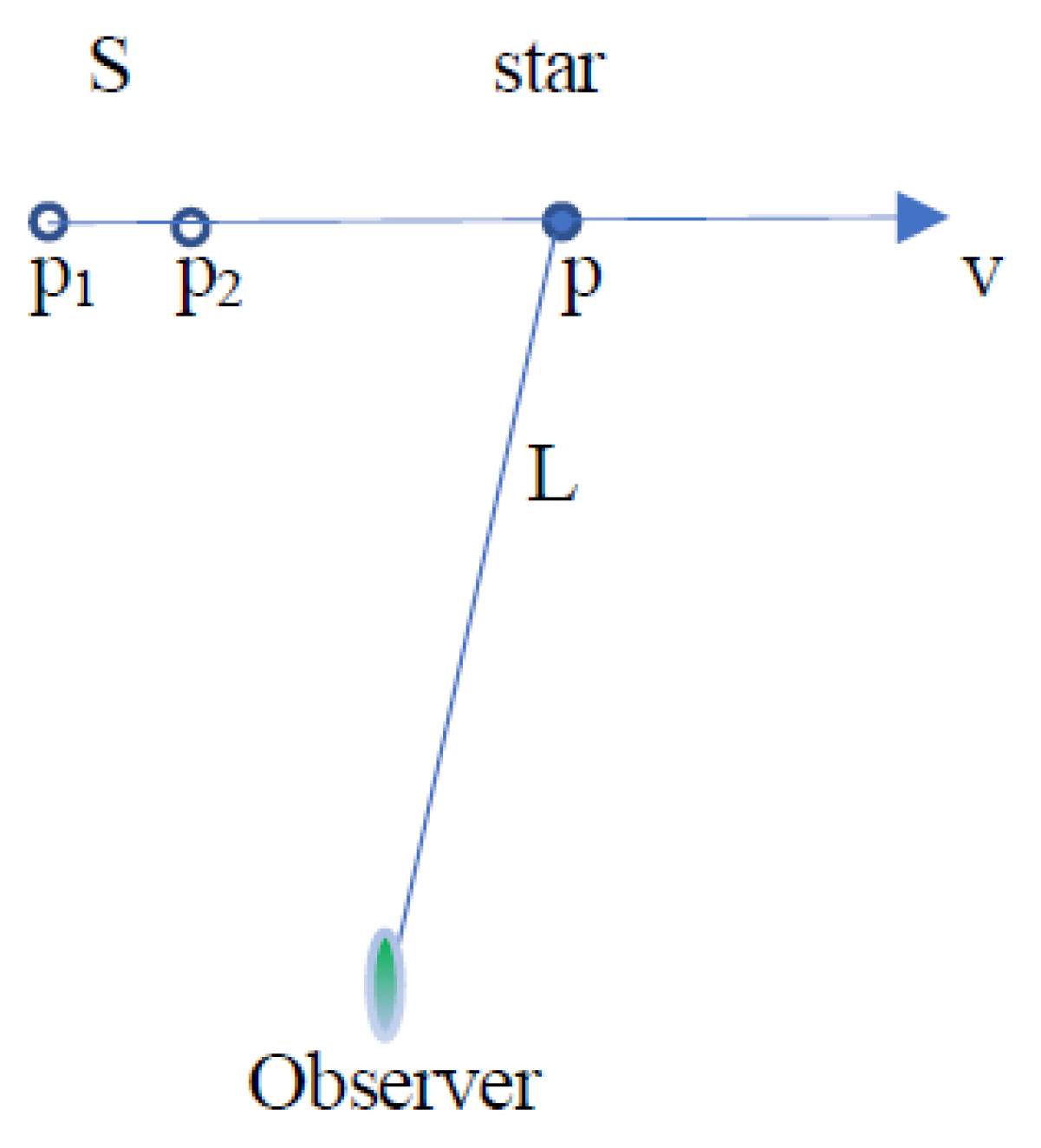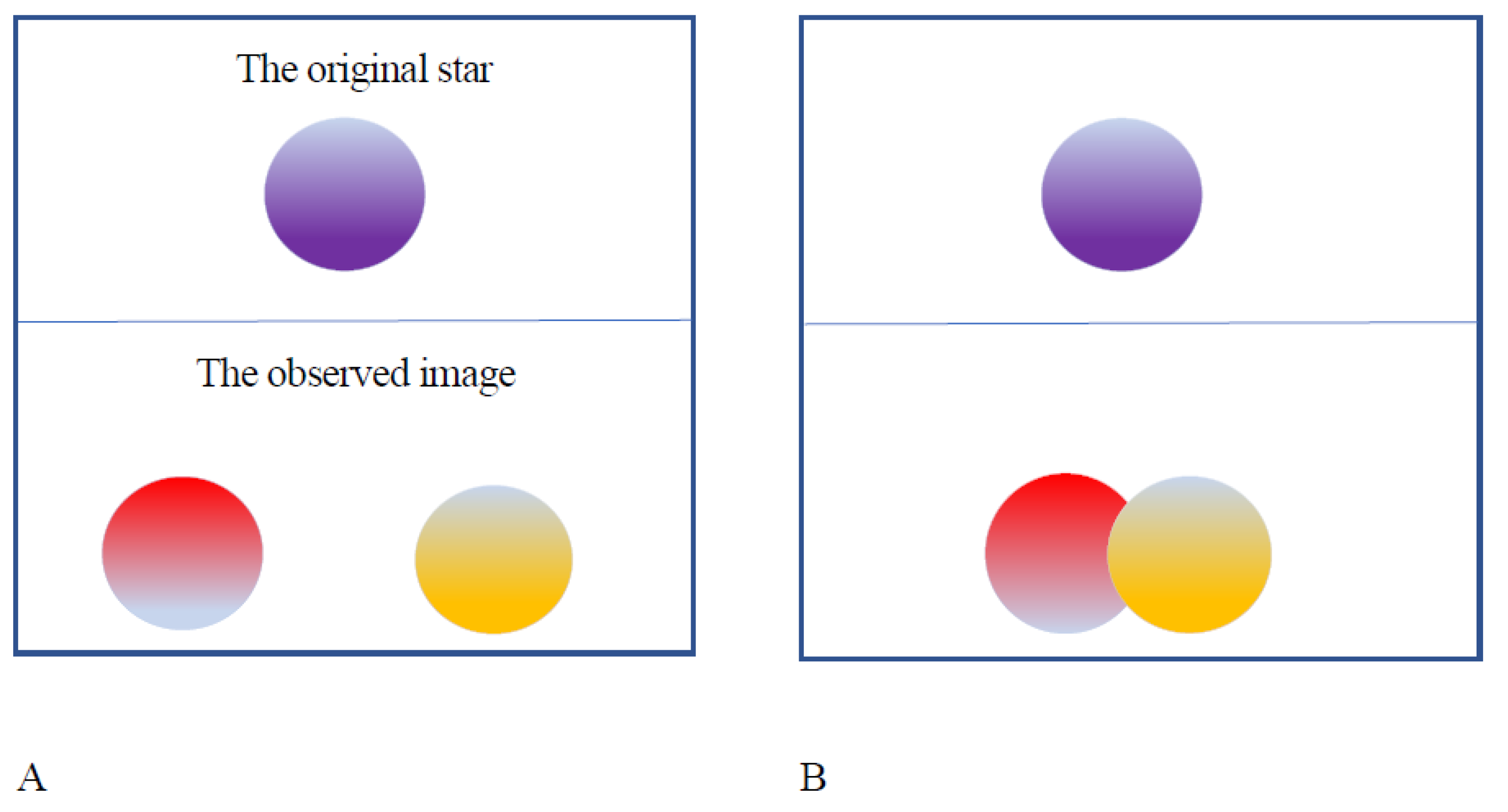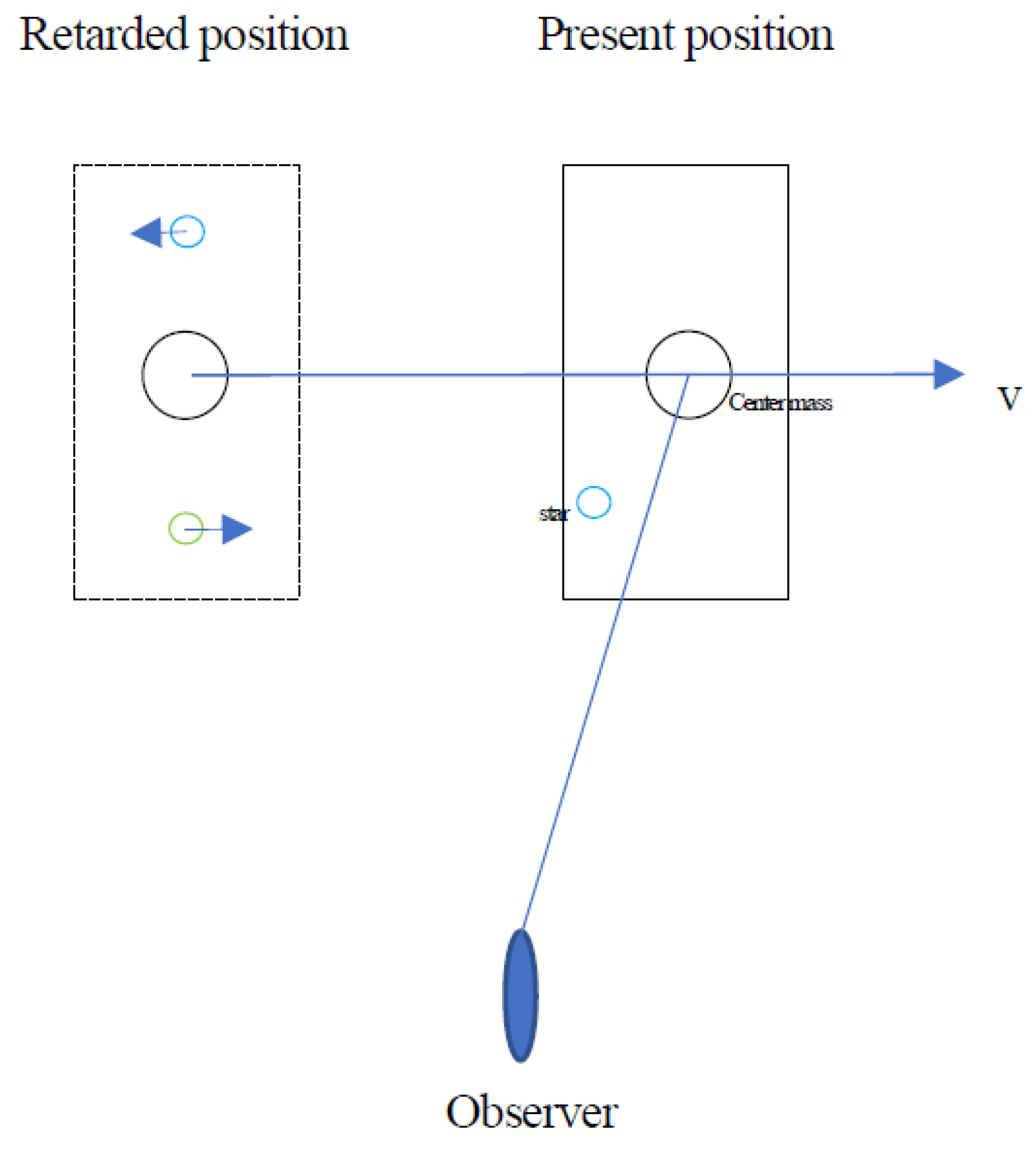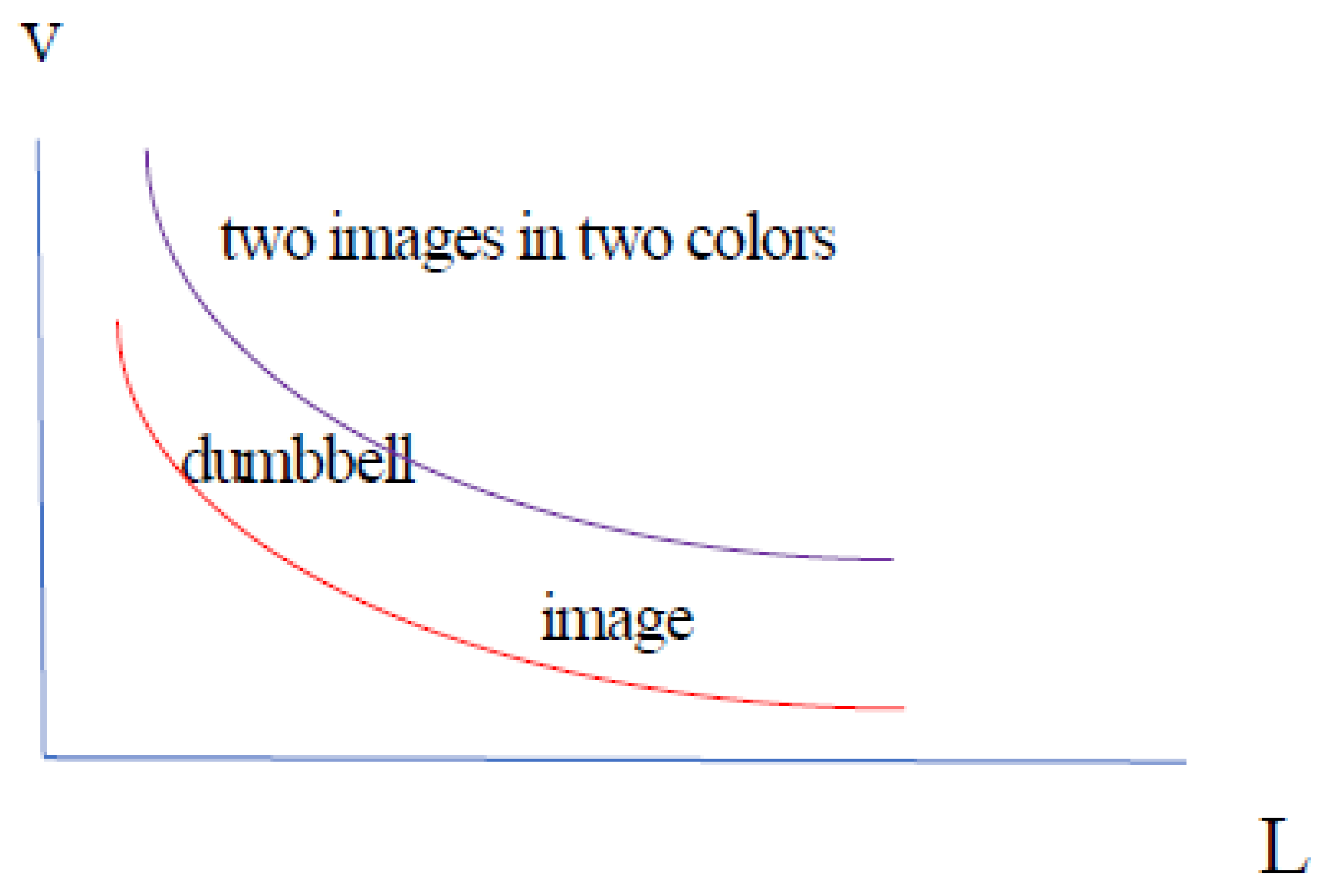1. Result
Dispersion of light in general medium was well
studied. The speed of light in the medium can be written as
Where, c is the speed of light measured on the
Earth, n is the refractive index, and are the electric constant and magnetic constant in
a medium. Here, c is also called the speed of light in a vacuum. The current
concept of vacuum is presented by Torricelli in 1643 [7].
In this vacuum, the gravitational field is not eliminated. From the Newton’s
prism experiment, we know, for a material with a certain and , the refractive indexes are different for the light ray with different
wave length.
By analogy to other medium, it could be assumed
that the electric constant and magnetic constant are different in the gravitational
fields with different field strength. Therefore, Equation (1) could be
rewritten as
Where, indexes the location. It means that for the
location around the Earth, the speed of light is while around a neutron star, the and are different which results in that the speed of
light is no longer .
Diffraction is produced from the property of wave,
including sound wave, electromagnetic radiation, and small moving particles [8]. The Huygens’ principle [9] told us that as a plane wave is propagated from
one medium into another one, this wave is refracted for that there is a time
delay between different sides of the wavefront. Therefore, refraction of light
is due to the wave propagation. As a light enters a strong gravitational field
from a vacuum or a weak field, the Huygens’ principle shall certainly function.
A refraction could be produced in this process. In addition, a gravitational
field can make light redshift and bent. It clearly shows that the motion of a
light is changed as it enters a new gravitational field.
Dispersion of light had been studied for a long
history [10]. Cauchy, Briot, Hartmann, Corady
and Sellmeier presented the formula for the dispersion. It showed that, for a
given material, the refraction index is only determined with the wavelength of
the light.
Therefore, dispersion of light in a gravitational
field is such a result that only is produced by the property of wave
propagation which can be well understood with classic physics.
The dispersion in gravitational field could be
observed from the image of a star with a strong field. For convenience, here,
only the simplest case that the light ray is vertical to the surface of the
medium is studied. In the case, there is not refraction for the light. As the
light emitted by a star is running through the gravitational field of the star,
under the condition that the field is uniform, the light cannot be refracted by
the field.
It is well known, for a star with a distance L
relative to the observer, this star at the present position p and at the
present time t cannot be observed for that a time is needed for the light running from the star to
the observer. It only can be observed at the retarded time and at the retarded position which, at the
retarded time, the star is at. Therefore, the observed image of the star is
that the star is at the retarded position and at retarded time.
In a medium, the speed of light is determined with
, where
is the wavelength of the light. Because of
dispersion, for the speed of the light with different wavelength, the retarded
time is determined with
In Equation (4),
is with different value. Therefore, under the
condition of dispersion, there shall be two (or more) retarded positions for a
star as shown in the
Figure 1.
The distance S between two retarded positions p
1
and p
2 is determined with
From Figure 1
we know, observed on the Earth, the image of a star is directly determined with
S. As
, (where, r is the radius of the star,) a star
shall appear two images in different colors as shown in
Figure 2A. As
, the image of a spherical star appears as a
dumbbell in two colors as shown in Figure 2B.
If light is dispersive in gravitational field, it
can have been generally observed. The first evidence for the dispersion of
light in gravitational field is the double(multi-)-image gravitational lensing.
Now, a large number of double-(multi-)image
gravitational lensing was observed [11].
The two conditions are needed to form double-image in a gravitational lensing
system. 1) There are two light curves. 2) There are different speeds and
refractive angles for the two curves. The two conditions can just be produced
from the dispersion of light in gravitational field. As a light ray is running
through a strong field, it is being bent by the field. In the same time, it is
being dispersed into two light curves with different speed and different
refractive angle. It is emphasized, if a light ray could not be split into two
rays, the double images could not be formed. In 1995, Pelt and coworkers [12] presented that the double-image in
gravitational lensing system is originated from two different light curves. The
time delay between the two light curves is determined with that one of the
light curves is shifted by the dispersion spectra. They explained the time
delay of QSO of 0957+561. With Pelt and coworkers’ conclusion, Burud and
coworkers [13] explained the gravitationally
lensed double QSO B1600+434. Therefore, although Pelt and coworkers [12,13] did not think that this dispersion spectra
is related with the gravitational field, they used the key point in the concept
of the dispersion of light in gravitational field: two light curves is shifted
by dispersion spectra. Their description is almost as that described with our Figures 1 and 2 although the physical reason of
the dispersion spectra in their work is different. It is shown that the
dispersion of light in gravitational field is needed to wholly understand the
double images in a gravitational lensing system.
In recent, it was observed that the observed size
of the image of a galaxy is a function of the wavelength of the light 14,15].
It directly shows that the observed size and distance of a celestial object is
affected by the wavelength of the light. A method is presented that the
distance of extragalactic can be measured with “the time lag between variations
in the short wavelength and long wavelength light from an active galactic
nucleus” [16]. It should imply that, light
dispersion in gravitational field is very important to have an accurate
measured result. (Please reference the Supplementary material A.)
The second evidence for our conclusion should be
the spectroscopic binary star. A spectroscopic binary is a star system
that can only be seen as more than one star by looking at its spectrum; through
a telescope, no matter what we do or how good our equipment is, it will always
look like one star. It is highly accordant with the conclusion as described in
the Figure 2A. Although it is thought
that there are two stars in a spectroscopic binary system, it has not been
excluded that it is a system that a star appears two images. We know, the
binary stars have been well observed. But, it was presented that the Poincaré’s
equation of Three-Body problem is invalid [17].
(The evidence is clear: the orbits of the Sun-Earth-Moon are absolutely stable.
But, in the Poincaré’s equation, these orbits are chaotic.) It was also shown
that the current theory of binary star is questioned. Therefore, further
observation and study about the spectroscopic binary system is needed.
Factually, the spectroscopic binary system is being studied [18,19]. Here, we found that, as shown in the
Figure 3, a star in the retarded positions can completely
appear a spectroscopic binary system. Here, it is emphasized that, any binary
system is always orbiting around a large center but the large center is usually
omitted [17]. And, it is noted that the
retarded positions in the Figure 3 can be
combined into many cases.
Third, the images of black hole [20,21] may be a possible evidence for the Figure 2B. Two features of the images of the
black hole should be accordant with the Figure 2B.
First, the images of the black hole are asymmetrical, or they are elongated.
From Figure 1 and Equation (5) we know,
as the band of the spectrum of a star is wider, the image of the star is
longer. Second, the wavelengths of the light are different at different part of
the image. 2B shows that the asymmetry is produced from the difference of the
wavelength. Generally, Figure 2B is
suitable to the celestial body with large radius and less distance L. It could
be concluded that the observed image of a star is not always a sphere.
From Equation (5), assuming
is a constant, the image of a star is determined
with L and v as shown in
Figure 4.
In Equation (5), can be treated as a constant and usually there is . Therefore, in Figure
4, the distance L is the main factor to the observed result. The
distance between two observed images can be very large as L is very large.
Figures 1–4
indicates that the spectroscopic binary system could be easily confirmed. (1) A
large distance L is needed for the spectroscopic binary system. (2) As L is
larger, the distance S between two spectroscopic binary stars is larger. (3)
Each image of the spectroscopic binary in the Figure
2 is with a unique wavelength. (4) The spectroscopic binary has a same
orbit around another center mass.
The possible forth evidence is very important but
need further observation. Figures 2 and 4
indicate that, as L is larger, the spectra of the observed image of a star is
less. In the very distant place, from Figure 2
we know, a star with several spectra should appear several images in which each
image is with one unique spectrum. It means that the observed image of star in
the very distant place is with only one spectrum and the numbers of the
observed images of one star are usually large than one. Therefore, our
conclusion could be further confirmed with the relationship between the
spectrum of star and the distance L. But, form Equation (4) we know, the speed
of the star and the difference of the refractive indexes also have an effect on the spectrum. It is noted
that, although was treated as a constant in the above, is greatly different for different field. As the
strength of a field is larger, is larger. It indicates that, for a super strong
field, should be important to the image of a star.
A gravitational field is a centripetal force. It is
more complicated than a general medium, such as a water. Therefore, the real
image of a star is more complicated than the Figure
2. First, usually, a gravitational field is not uniform. The light can
be refracted by the field. Therefore, the image is related with the refracted
angle of the light and the velocity v of the star. For the combinations of the
directions of the star moving and that of the refracted angle, there should be
different image. Second, light can be bent by gravity, it could result in that
the motion of a light ray in a gravitational field is very complicated. As the
dispersion is considered, the motion of a light ray in a strong field shall be
complicated than that illustrated in the Ref. [2].
Under the conditions of both the bending of light by gravity and the
dispersion, in a super strong gravitational field, for the moving of the star,
the field strength is different relative to the light with different
wavelength. For example, as shown in the Figure
1s in the Supplementary material B, as the light with is being acting by the field with the strength , the light with has not arrived at . The light with only can be acted by . In a super strong field, is very large in a short distance. It results in
that the lines that the light with different wavelength running is radically
different. And, it is emphasized that, the distance L between us and a star is
very large. A little variation of the direction of a light shall result in that
this light cannot be observed on the Earth. For example, as a little angle is
between two light rays, one of the light rays can arrive at the Earth while the
another shall arrive at a place very distant from the Earth. Therefore, as the
angle of the light bent by gravity is very large, this effect could not be
observed in a whole image. It indicates that only the effect that in the field
with proper strength could be observed wholly. It indicates that many of the
observable images of a stars could be only part of the images of the real
stars. Therefore, in current theory, under the condition that the dispersion of
light in gravitational field is not considered, many observed images of star
are not a real star. Instead, it only is part of the images of a real star. For
example, due to the gravitational lensing, a star can appear several images [22]. It is important to understand a galaxy. For
example, in a galaxy, as the numbers of the images is much larger than that of
the real stars, it should be an important factor to assess accurately the total
mass of the galaxy.
Dispersion of light in free space was measured
through that the speed of light can be slowed in a vacuum [23,24]. Two conclusions could be obtained from this
measurement. First, the images analogous to that in the Figure 2 could be produced by the dispersion in
free space. Second, dispersion in free space could be enlarged or varied in a
strong gravitational field. (please reference the Supplementary material B.)
2. Discussion
The speed of light has been regarded as a
cornerstone of current physics. It is believed that the speed of light in a
vacuum is a constant which is the fastest velocity in our universe. However, as
pointed out in the above, the speed of light in a vacuum has never been
measured and cannot be measured with current technology. In fact, in Einstein’s
theory of relativity, it was implied that the understandings about the speed of
light can be developed. On one hand, it is claimed that the speed of light is
constant in vacuum. On another hand, it is claimed that a light ray can be bent
by gravity, and taking the bending of light by gravity as the main evidence for
the general theory of relativity. Bending of light by gravity factually implies
that the speed of light can be different in different gravitational field. It
is easy to know that as the field is super strong, as illustrated in Ref [2]., the motion of light affected by gravity can be
radically different from that on the Earth.
Till now, the only theory for the action of gravity
on the speed of light is the bending of light by gravity. It is noted that it
is Newton who first presented that light can be bent by gravity in 1660s [26]. And, von Soldner obtained the formula for it
in 1804 [27]. This formula had not been
improved in Einstein’s general relativity [28].
However, such old a theory need be developed. In quantum mechanics, the
reflection of the wavelength of light to the gravity is an important subject.
Several other new observations about the speed of
light were obtained. First, it is measured that the quantum teleportation is
faster-than-light which can be used for communication [29–31]. In Refs [29–31].
it was clearly sentenced that the faster-than-light quantum teleportation can
be used for communication. Second, it was measured that the speed of light in a
vacuum is different due to the dispersion in free space [23–25]. It seems a strong supporter for our
conclusion of the light dispersion in gravitational field. Third, it was measured
that the photon can be accelerated along the direction vertical to its velocity
[32–34]. It may lead to the new discovery of
physics. Third, it was observed that the speed of gravity is much larger than
the speed of light [35–37]. And, the negative
speed of light and the fast light were measured.
And, we emphasize that the speed of light is with
particular characteristic. First, in , no other particle is faster than light, and the
velocity and mass of a particle are varied according to this formula. Second,
astronomical observation shows that the speed of light is not affected by the
speed of the source. If the speed of light was affected by the speed v of the
source, the speed of light emitted from the sources should be . Because of the orbital motion of the celestial
body, relative to the observer on the Earth, it should lead to that, from the
distant celestial bodies, the light emitted later could arrive at the Earth
earlier. If it was so, for the binary star, it should appear that there are
many stars, generally called as the “Phantom Phenomenon”. Third, the Fizeau
experiment [38] also shows the special
relationship between the speed of light and the source. In Fizeau experiment,
the speed of light is not completely independent of the speed of the source,
but the relationship is different from that of general objects such as that
between the speed of a boat and that of the water in a river. Now, we have not
known the reason for the particularities of the speed of light.
Additionally, it was well known that, there are
many different cases for Equation (2). and are certain for a material. But, sometimes, is negative. For some materials, there are . So, Equation (2) has not been completely
understood.
These new observations and the particular
characteristic showed that the speed of light is very complicated. It need be
further studied and understood. As the strong gravitational field on the light
is studied, some new features of the speed of light shall be discovered.








